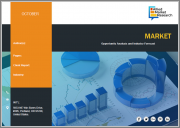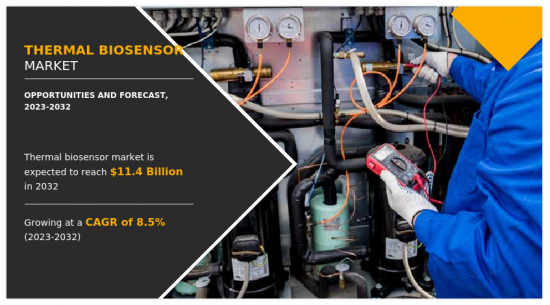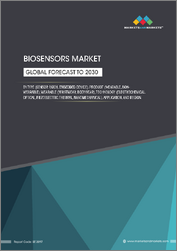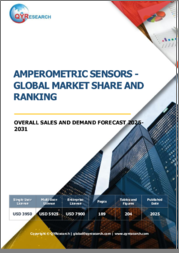
|
시장보고서
상품코드
1414868
세계 열 바이오 센서 시장 : 용도별, 유통 채널별 : 기회 분석과 산업 예측(2023년-2032년)Thermal Biosensor Market By Application (Point-of-care, Home Diagnostics, Research Lab, Food and Beverages, Environmental monitoring, Biodefense), By Distribution Channel : Global Opportunity Analysis and Industry Forecast, 2023-2032 |
||||||
열 바이오 센서 시장은 2022년에 51억 달러로 평가되었으며, 2023년과 2032년 사이에 복합 연간 성장률(CAGR) 8.5%로 성장할 전망이며 2032년까지 114억 달러에 이를 것으로 추정됩니다.

일상 생활에서 열 바이오 센서는 건강 관리에서 중요한 역할을 담당합니다. 체온을 측정하는 의료용 체온계에 일반적으로 채용되어 감염증 등 다양한 질병을 나타내는 발열의 조기 발견에 도움이 됩니다. 또한 이러한 센서는 당뇨병 환자용 포도당 모니터링 시스템에 사용되며 정확하고 실시간 데이터를 제공하여 혈당 관리를 지원하고 인슐린 복용량과 식습관을 적시에 조정할 수 있습니다. 또한 식품의 안전성을 보장하기 위해서 열 바이오센서는 운송중이나 보관중의 신선품의 온도를 감시·조정하고 안전한 소비 파라미터의 범위내에 유지하기 위해 이용되고 있습니다.
세계에서 열 바이오 센서의 미래는 상당히 유망합니다. 기술이 발전함에 따라 감도, 특이성 및 검출 속도의 추가 향상이 기대됩니다. 그 결과 의료 및 환경 모니터링과 같은 다양한 산업에서 더 빠르고 정확한 진단이 가능할 수 있습니다. 게다가, 현재 진행 중인 조사는 신규의 생체 수용체나 변환 소자가 발견될 가능성이 높고, 열식 바이오센서로 검출 가능한 생체 분자의 스펙트럼이 넓어집니다. 인공지능과 나노기술과 같은 최첨단 기술의 통합은 또한 그 능력을 증폭하고 용도를 넓힐 수 있습니다.
게다가, 웨어러블 기기에 열 바이오센서를 통합하는 것이 더욱 확대될 것으로 예상됩니다. 이를 통해 개인의 건강 모니터링에 혁명이 일어날 수 있으며 특정 바이오마커를 지속적으로 모니터링하여 잠재적인 건강 문제를 조기에 발견할 수 있습니다. 이 사전활성 건강 관리 접근법은 만성 질환의 관리와 전반적인 건강 상태의 개선으로 이어질 수 있습니다. 또한 환경 모니터링은 열 바이오센서를 도입함으로써 오염물질의 효율적인 검출과 제어를 가능하게 하고, 세계 지역사회가 보다 깨끗하고 안전한 환경이 될 것으로 기대됩니다. 그러므로 열 바이오센서는 이미 일상 생활의 다양한 장면에서 그 중요성을 입증하고 있으며, 앞으로의 진보는 건강, 환경 보전, 그리고 전 세계 행복에 혁명을 가져올 수 있는 큰 잠재력을 가지고 있습니다.
열 바이오 센서 시장은 건강 진단 수요 증가, 환경 모니터링 중요성 증가 및 식품 안전 수요 급증으로 현저한 성장이 예상됩니다. 또한, 생명공학 분야의 성장은 예측 기간 동안 시장 성장에 유리한 기회를 제공할 것으로 기대됩니다. 반대로 생산 비용의 급격한 상승은 열 바이오 센서 시장의 성장을 제한하고 있습니다.
열 바이오 센서 시장은 용도, 유통 채널, 지역별로 분석됩니다. 용도별로, 시장은 포인트 오브 케어(POC), 재택 진단, 연구소, 식품 및 음료, 환경 모니터링, 바이오디펜스로 분류됩니다. 2022년에는 위의 포인트 오브 케어(POC) 분야가 시장을 독점하고 2032년까지 주요 시장 점유율을 획득할 것으로 예측됩니다. 유통 채널별로 시장은 온라인과 오프라인으로 이분됩니다. 2022년에는 오프라인 부문이 시장을 독점하고 2032년까지 온라인 부문이 주요 시장 점유율을 획득할 것으로 예상됩니다.
지역별로는 북미(미국, 캐나다, 멕시코), 유럽(영국, 독일, 프랑스, 기타 유럽), 아시아태평양(중국, 일본, 인도, 한국, 기타 아시아태평양), 라틴아메리카(중남미, 중동· 아프리카)에서 열 바이오 센서 시장 동향을 분석했습니다.
이 보고서에서 제공하는 세계 주요 열 바이오 센서 시장 기업의 경쟁 분석 및 프로파일에는 DowDupont Inc., LifeSignals, Nova Biomedical Corporation, Massimo Corporation, Siemens, Fitbit(Google), Garmin, TA Instruments 등이 있습니다. 포함됩니다. 열 바이오 센서 시장의 주요 기업이 채택하는 주요 전략은 제품 투입, 신제품 개척, 협업, 업그레이드입니다.
목차
제1장 서론
제2장 주요 요약
제3장 시장 개요
- 시장 정의와 범위
- 주요 조사 결과
- 영향요인
- 주요 투자 기회
- Porter's Five Forces 분석
- 시장 역학
- 성장 촉진요인
- 헬스케어 진단에 있어서 수요 증가
- 환경 모니터링 중시의 고조
- 식품안전에 대한 수요의 급증
- 억제요인
- 생산 비용의 급상승
- 기회
- 생명공학 분야의 성장
- 성장 촉진요인
제4장 열 바이오 센서 시장 : 용도별
- 개요
- 포인트 오브 케어(POC)
- 재택 진단
- 연구소
- 식품 및 음료
- 환경 모니터링
- 바이오디펜스
제5장 열 바이오 센서 시장 : 유통 채널별
- 개요
- 온라인
- 오프라인
제6장 열 바이오 센서 시장 :지역별
- 개요
- 북미
- 미국
- 캐나다
- 멕시코
- 유럽
- 영국
- 독일
- 프랑스
- 기타
- 아시아태평양
- 중국
- 일본
- 인도
- 한국
- 기타
- 라틴아메리카· 중동· 아프리카
- 라틴아메리카
- 중동
- 아프리카
제7장 경쟁 구도
- 소개
- 주요 성공 전략
- 주요 10개사의 제품 매핑
- 경쟁 대시보드
- 경쟁 히트맵
- 주요 기업의 포지셔닝(2022년)
제8장 기업 프로파일
- DowDupont Inc.
- LifeSignals
- Nova Biomedical Corporation
- Masimo Corporation
- TA Instruments
- Siemens
- Fitbit(Google)
- Garmin
According to a new report published by Allied Market Research, titled, "Thermal Biosensor Market," The thermal biosensor market was valued at $5.1 billion in 2022, and is estimated to reach $11.4 billion by 2032, growing at a CAGR of 8.5% from 2023 to 2032.

In everyday life, thermal biosensors have crucial roles in healthcare. They are commonly employed in medical thermometers to gauge body temperature, aiding in early fever detection, which can indicate various illnesses, including infections. Additionally, these sensors are used in glucose monitoring systems for diabetics, assisting individuals in managing their blood sugar levels by providing precise and real-time data, enabling timely adjustments to insulin dosage or dietary habits. Moreover, in ensuring food safety, thermal biosensors are utilized to oversee and regulate the temperature of perishable goods during transportation and storage, ensuring they remain within safe consumption parameters.
The future of thermal biosensors on a global scale holds considerable promise. With ongoing technological progress, we anticipate further improvements in their sensitivity, specificity, and speed of detection. This could lead to swifter and more accurate diagnostics in various industries, including healthcare and environmental monitoring. Furthermore, ongoing research is likely to yield novel bioreceptors and transducer elements, broadening the spectrum of detectable biomolecules by thermal biosensors. The integration of cutting-edge technologies like artificial intelligence and nanotechnology could additionally amplify their capabilities and broaden their applications.
Furthermore, the integration of thermal biosensors into wearable devices is projected to become more widespread. This could revolutionize personal health monitoring, allowing individuals to continuously monitor specific biomarkers, offering early indications of potential health issues. This proactive healthcare approach could result in improved management of chronic conditions and overall health outcomes. In addition, to environmental monitoring, deploying thermal biosensors could lead to more efficient detection and control of pollutants, contributing to a cleaner and safer environment for communities globally. Therefore, thermal biosensors have already demonstrated their significance in various aspects of daily life, and their forthcoming advancements hold tremendous potential for revolutionizing healthcare, environmental preservation, and overall well-being worldwide.
The thermal biosensor market is expected to witness notable growth owing to the increase in demand for healthcare diagnosis, the growing emphasis on environmental monitoring, and the surge in demand for food safety. Moreover, the growing biotechnology sector is expected to provide a lucrative opportunity for the growth of the market during the forecast period. On the contrary, rapidly increasing production costs limit the growth of the thermal biosensor market.
The Thermal biosensor market is analyzed by application, distribution channel, and region. On the basis of application, the market is bifurcated into point-of-care (POC), home diagnostics, research labs, food and beverages, environmental monitoring, and biodefense. In 2022, the above point-of-care (POC) segment dominated the market, and it is expected to acquire a major market share by 2032. On the basis of distribution channel, the market is bifurcated into online, and offline. In 2022, the above offline segment dominated the market, and the online segment is expected to acquire a major market share by 2032.
On the basis of region, the thermal biosensor market trends are analyzed across North America (the U.S., Canada, and Mexico), Europe (the UK, Germany, France, and the rest of Europe), Asia-Pacific (China, Japan, India, South Korea, and rest of Asia-Pacific), and LAMEA (Latin America, Middle East, and Africa).
Competitive analysis and profiles of the major global Thermal biosensor market players that have been provided in the report include DowDupont Inc., LifeSignals, Nova Biomedical Corporation, Masimo Corporation, Siemens, Fitbit (Google), Garmin, and TA Instruments. The key strategies adopted by the major players in the Thermal biosensor market are product launch, new product development, collaboration, and upgradation.
Key Benefits For Stakeholders
- This report provides a quantitative analysis of the market segments, current trends, estimations, and dynamics of the thermal biosensor market analysis from 2022 to 2032 to identify the prevailing thermal biosensor market opportunities.
- The market research is offered along with information related to key drivers, restraints, and opportunities.
- Porter's five forces analysis highlights the potency of buyers and suppliers to enable stakeholders make profit-oriented business decisions and strengthen their supplier-buyer network.
- In-depth analysis of the thermal biosensor market segmentation assists to determine the prevailing market opportunities.
- Major countries in each region are mapped according to their revenue contribution to the global market.
- Market player positioning facilitates benchmarking and provides a clear understanding of the present position of the market players.
- The report includes the analysis of the regional as well as global thermal biosensor market trends, key players, market segments, application areas, and market growth strategies.
Additional benefits you will get with this purchase are:
- Quarterly Update and* (only available with a corporate license, on listed price)
- 5 additional Company Profile of client Choice pre- or Post-purchase, as a free update.
- Free Upcoming Version on the Purchase of Five and Enterprise User License.
- 16 analyst hours of support* (post-purchase, if you find additional data requirements upon review of the report, you may receive support amounting to 16 analyst hours to solve questions, and post-sale queries)
- 15% Free Customization* (in case the scope or segment of the report does not match your requirements, 15% is equivalent to 3 working days of free work, applicable once)
- Free data Pack on the Five and Enterprise User License. (Excel version of the report)
- Free Updated report if the report is 6-12 months old or older.
- 24-hour priority response*
- Free Industry updates and white papers.
Possible Customization with this report (with additional cost and timeline, please talk to the sales executive to know more)
- Product Life Cycles
- New Product Development/ Product Matrix of Key Players
- Additional company profiles with specific to client's interest
Key Market Segments
By Application
- Point-of-care (POC)
- Home Diagnostics
- Research Lab
- Food and Beverages
- Environmental monitoring
- Biodefense
By Distribution Channel
- Online
- Offline
By Region
- North America
- U.S.
- Canada
- Mexico
- Europe
- UK
- Germany
- France
- Rest of Europe
- Asia-Pacific
- China
- Japan
- India
- South Korea
- Rest of Asia-Pacific
- LAMEA
- Latin America
- Middle East
- Africa
Key Market Players:
- Fitbit (Google)
- DowDupont Inc.
- LifeSignals
- Masimo Corporation
- Siemens
- Garmin
- Nova Biomedical Corporation
- TA Instruments
TABLE OF CONTENTS
CHAPTER 1: INTRODUCTION
- 1.1. Report description
- 1.2. Key market segments
- 1.3. Key benefits to the stakeholders
- 1.4. Research methodology
- 1.4.1. Primary research
- 1.4.2. Secondary research
- 1.4.3. Analyst tools and models
CHAPTER 2: EXECUTIVE SUMMARY
- 2.1. CXO Perspective
CHAPTER 3: MARKET OVERVIEW
- 3.1. Market definition and scope
- 3.2. Key findings
- 3.2.1. Top impacting factors
- 3.2.2. Top investment pockets
- 3.3. Porter's five forces analysis
- 3.3.1. Low to high bargaining power of suppliers
- 3.3.2. Moderate to high threat of new entrants
- 3.3.3. High to moderate threat of substitutes
- 3.3.4. Low to high intensity of rivalry
- 3.3.5. Moderate to high bargaining power of buyers
- 3.4. Market dynamics
- 3.4.1. Drivers
- 3.4.1.1. The increase in demand in healthcare diagnosis
- 3.4.1.2. The growing emphasis on environmental monitoring
- 3.4.1.3. The surge in demand for food safety
- 3.4.2. Restraints
- 3.4.2.1. Rapidly increasing production costs
- 3.4.3. Opportunities
- 3.4.3.1. Growing biotechnology sector
- 3.4.1. Drivers
CHAPTER 4: THERMAL BIOSENSOR MARKET, BY APPLICATION
- 4.1. Overview
- 4.1.1. Market size and forecast
- 4.2. Point-of-care (POC)
- 4.2.1. Key market trends, growth factors and opportunities
- 4.2.2. Market size and forecast, by region
- 4.2.3. Market share analysis by country
- 4.3. Home Diagnostics
- 4.3.1. Key market trends, growth factors and opportunities
- 4.3.2. Market size and forecast, by region
- 4.3.3. Market share analysis by country
- 4.4. Research Lab
- 4.4.1. Key market trends, growth factors and opportunities
- 4.4.2. Market size and forecast, by region
- 4.4.3. Market share analysis by country
- 4.5. Food and Beverages
- 4.5.1. Key market trends, growth factors and opportunities
- 4.5.2. Market size and forecast, by region
- 4.5.3. Market share analysis by country
- 4.6. Environmental monitoring
- 4.6.1. Key market trends, growth factors and opportunities
- 4.6.2. Market size and forecast, by region
- 4.6.3. Market share analysis by country
- 4.7. Biodefense
- 4.7.1. Key market trends, growth factors and opportunities
- 4.7.2. Market size and forecast, by region
- 4.7.3. Market share analysis by country
CHAPTER 5: THERMAL BIOSENSOR MARKET, BY DISTRIBUTION CHANNEL
- 5.1. Overview
- 5.1.1. Market size and forecast
- 5.2. Online
- 5.2.1. Key market trends, growth factors and opportunities
- 5.2.2. Market size and forecast, by region
- 5.2.3. Market share analysis by country
- 5.3. Offline
- 5.3.1. Key market trends, growth factors and opportunities
- 5.3.2. Market size and forecast, by region
- 5.3.3. Market share analysis by country
CHAPTER 6: THERMAL BIOSENSOR MARKET, BY REGION
- 6.1. Overview
- 6.1.1. Market size and forecast By Region
- 6.2. North America
- 6.2.1. Key market trends, growth factors and opportunities
- 6.2.2. Market size and forecast, by Application
- 6.2.3. Market size and forecast, by Distribution Channel
- 6.2.4. Market size and forecast, by country
- 6.2.4.1. U.S.
- 6.2.4.1.1. Market size and forecast, by Application
- 6.2.4.1.2. Market size and forecast, by Distribution Channel
- 6.2.4.2. Canada
- 6.2.4.2.1. Market size and forecast, by Application
- 6.2.4.2.2. Market size and forecast, by Distribution Channel
- 6.2.4.3. Mexico
- 6.2.4.3.1. Market size and forecast, by Application
- 6.2.4.3.2. Market size and forecast, by Distribution Channel
- 6.3. Europe
- 6.3.1. Key market trends, growth factors and opportunities
- 6.3.2. Market size and forecast, by Application
- 6.3.3. Market size and forecast, by Distribution Channel
- 6.3.4. Market size and forecast, by country
- 6.3.4.1. UK
- 6.3.4.1.1. Market size and forecast, by Application
- 6.3.4.1.2. Market size and forecast, by Distribution Channel
- 6.3.4.2. Germany
- 6.3.4.2.1. Market size and forecast, by Application
- 6.3.4.2.2. Market size and forecast, by Distribution Channel
- 6.3.4.3. France
- 6.3.4.3.1. Market size and forecast, by Application
- 6.3.4.3.2. Market size and forecast, by Distribution Channel
- 6.3.4.4. Rest of Europe
- 6.3.4.4.1. Market size and forecast, by Application
- 6.3.4.4.2. Market size and forecast, by Distribution Channel
- 6.4. Asia-Pacific
- 6.4.1. Key market trends, growth factors and opportunities
- 6.4.2. Market size and forecast, by Application
- 6.4.3. Market size and forecast, by Distribution Channel
- 6.4.4. Market size and forecast, by country
- 6.4.4.1. China
- 6.4.4.1.1. Market size and forecast, by Application
- 6.4.4.1.2. Market size and forecast, by Distribution Channel
- 6.4.4.2. Japan
- 6.4.4.2.1. Market size and forecast, by Application
- 6.4.4.2.2. Market size and forecast, by Distribution Channel
- 6.4.4.3. India
- 6.4.4.3.1. Market size and forecast, by Application
- 6.4.4.3.2. Market size and forecast, by Distribution Channel
- 6.4.4.4. South Korea
- 6.4.4.4.1. Market size and forecast, by Application
- 6.4.4.4.2. Market size and forecast, by Distribution Channel
- 6.4.4.5. Rest of Asia-Pacific
- 6.4.4.5.1. Market size and forecast, by Application
- 6.4.4.5.2. Market size and forecast, by Distribution Channel
- 6.5. LAMEA
- 6.5.1. Key market trends, growth factors and opportunities
- 6.5.2. Market size and forecast, by Application
- 6.5.3. Market size and forecast, by Distribution Channel
- 6.5.4. Market size and forecast, by country
- 6.5.4.1. Latin America
- 6.5.4.1.1. Market size and forecast, by Application
- 6.5.4.1.2. Market size and forecast, by Distribution Channel
- 6.5.4.2. Middle East
- 6.5.4.2.1. Market size and forecast, by Application
- 6.5.4.2.2. Market size and forecast, by Distribution Channel
- 6.5.4.3. Africa
- 6.5.4.3.1. Market size and forecast, by Application
- 6.5.4.3.2. Market size and forecast, by Distribution Channel
CHAPTER 7: COMPETITIVE LANDSCAPE
- 7.1. Introduction
- 7.2. Top winning strategies
- 7.3. Product mapping of top 10 player
- 7.4. Competitive dashboard
- 7.5. Competitive heatmap
- 7.6. Top player positioning, 2022
CHAPTER 8: COMPANY PROFILES
- 8.1. DowDupont Inc.
- 8.1.1. Company overview
- 8.1.2. Key executives
- 8.1.3. Company snapshot
- 8.1.4. Operating business segments
- 8.1.5. Product portfolio
- 8.1.6. Business performance
- 8.2. LifeSignals
- 8.2.1. Company overview
- 8.2.2. Key executives
- 8.2.3. Company snapshot
- 8.2.4. Operating business segments
- 8.2.5. Product portfolio
- 8.2.6. Key strategic moves and developments
- 8.3. Nova Biomedical Corporation
- 8.3.1. Company overview
- 8.3.2. Key executives
- 8.3.3. Company snapshot
- 8.3.4. Operating business segments
- 8.3.5. Product portfolio
- 8.3.6. Key strategic moves and developments
- 8.4. Masimo Corporation
- 8.4.1. Company overview
- 8.4.2. Key executives
- 8.4.3. Company snapshot
- 8.4.4. Operating business segments
- 8.4.5. Product portfolio
- 8.4.6. Business performance
- 8.4.7. Key strategic moves and developments
- 8.5. TA Instruments
- 8.5.1. Company overview
- 8.5.2. Key executives
- 8.5.3. Company snapshot
- 8.5.4. Operating business segments
- 8.5.5. Product portfolio
- 8.5.6. Business performance
- 8.5.7. Key strategic moves and developments
- 8.6. Siemens
- 8.6.1. Company overview
- 8.6.2. Key executives
- 8.6.3. Company snapshot
- 8.6.4. Operating business segments
- 8.6.5. Product portfolio
- 8.6.6. Business performance
- 8.6.7. Key strategic moves and developments
- 8.7. Fitbit (Google)
- 8.7.1. Company overview
- 8.7.2. Key executives
- 8.7.3. Company snapshot
- 8.7.4. Operating business segments
- 8.7.5. Product portfolio
- 8.7.6. Business performance
- 8.7.7. Key strategic moves and developments
- 8.8. Garmin
- 8.8.1. Company overview
- 8.8.2. Key executives
- 8.8.3. Company snapshot
- 8.8.4. Operating business segments
- 8.8.5. Product portfolio
- 8.8.6. Business performance



















